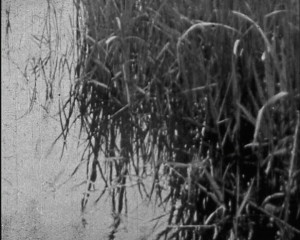A film capturing slices of everyday life, narrativizing Mori’s small children playing with each other.
"A day in the life of a man who is in much of a hurry to get somewhere. As he travels along his hurried way we are right in there enjoying his anxious moments as he transfers from one public conveyance to another. We are of course much relieved when we learn that he has arrived in good time" PSA Journal, Nov. 1959, 48.
"Articles in Movie Makers have often advocated experimenting with travel continuities by selecting a single theme and illustrating it with sequences made in many different countries. The entertainment value of this method is beautifully illustrated by Water, filmed by B. H. Blood, ACL. This picture is made up of sequences of water, waterways, wells and ice in a variety of places in the world and ends with a sequence in the home of the maker. Any emphasis on mechanics which this theme might seem to entail is entirely obviated by the dramatically interesting scenes that Mr. Blood selected to illustrate his idea." Movie Makers, Dec. 1932, 561-562.
"The film Water, 400 ft., 16mm which took a first award by the unanimous vote of the judges in a recent interclub movie contest, was drawn from more than 7500 feet of film, exposed over a period of nearly four years. It is a splendid example of the synthesized short subject, shrewdly built up from scattered material around a simple continuity theme. For this film the continuity idea was found in the common phrase, "Water, water everywhere." Scenes of water in many places, in many forms and in many uses were compared and contrasted, each new sequence being connected to the last by a clever and effective title. The film was produced by B. H. Blood, ACL, in Hartford, Conn., who deserves every credit [or his intelligent adaptation of the best features of the professional subject." Movie Makers, July 1932, 322.
"Fred Hudson and Donal Michalsky of Los Angeles combined their talents to produce on black-and-white film the origin of a mountain storm and its eventual metamorphosis as a turbulent stream of water. The storm is depicted in gathering clouds moving swiftly among mountain peaks, thanks to ultra-speed photography. Highly artistic shots of the first raindrops falling on a pool indicate the break of the storm, and the camera then records in excellent rainfall shots the progression of the storm, forming of rivulets and their eventual building up to a mountain stream. The various moods are enhanced by the theme music on the sound track, excellently recorded." American Cinematographer, May 1951, 192.

"A detailed study of a Japanese waterside community, emphasising their dependence on boats for most aspects of their lives. Catching fish, getting from home to the fields and taking produce to market. Significant detail of rural subsistence - fertilising fields, cutting rushes and women using foot-powered water wheel." (EAFA Database)
"Glen H. Turner brings to us the song of the desert and the water wheel that turns continuously. We move from the melting snows on to the streams, lakes and rivers. The churning rivers, increasing in power and rhythm, brown with the soil of the desert, the power for the water wheel. The slow, great turning water wheel pours forth the brown water, the life of vegetation in the gray hills, casting its shadow, its red shadow in the setting sun" PSA Journal, Nov. 1958, 46.
"A blue lake area that invites sun lovers, bathers, fishermen, and skiing in winter. The picture is about the local people in the Queenstown area, the people who go about their daily events and habits, such as weddings, small boys catching frogs in a lily pond, shopping areas, the filling station, boat service, and the mailman, as if the visitors were part of the community. We travel with one of the small planes as it goes on a mission to drop supplies to men in the forestry service. The local activities of these people remind us so much of our own experiences" PSA Journal, Oct. 1962, 36.
Total Pages: 299